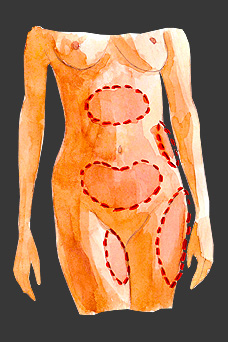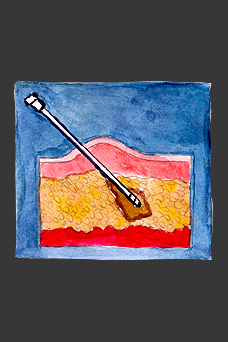Facial surgery
Breast surgery
Other operations
Liposuction
Non-surgical procedures
Liposuction
Liposuction is designed to remove excess fat from various parts of the body (chin, cheeks, neck, upper arms, chest, abdomen, buttocks, thighs, knees, lower legs, or ankles). This procedure can also form part of fat transplantation, a procedure when the patient's own fat is taken from one site, processed, and then injected into another location on the patient's body.
Procedure
Liposuction is performed with a special cannula connected to a vacuum machine. The cannula is introduced under the skin through a series of small skin incisions. Prior to the liposuction procedure, the tissues are flooded with a solution of anaesthetics and vasoconstrictors, in order to reduce bleeding during the procedure, and ease postoperative pain. The fat is then evenly sucked out of subcutaneous tissue with the cannula being operated in a pendulous motion. The cannula is removed after the procedure and the incisions are closed.
Liposuction is designed to remove excess fat from various parts of the body (chin, cheeks, neck, upper arms, chest, abdomen, buttocks, thighs, knees, lower legs, or ankles). This procedure can also form part of fat transplantation, a procedure when the patient's own fat is taken from one site, processed, and then injected into another location on the patient's body.
Procedure
Liposuction is performed with a special cannula connected to a vacuum machine. The cannula is introduced under the skin through a series of small skin incisions. Prior to the liposuction procedure, the tissues are flooded with a solution of anaesthetics and vasoconstrictors, in order to reduce bleeding during the procedure, and ease postoperative pain. The fat is then evenly sucked out of subcutaneous tissue with the cannula being operated in a pendulous motion. The cannula is removed after the procedure and the incisions are closed.
| Liposuction | ||||
 |
 |
|||
| Typical zones of liposuction | Cannula used for liposuction in subcutaneous tissue | |||
Operation risks
Liposuction, like any other intervention, may have adverse effects such as reaction to anaesthesia, pain, burning, secretions at the skin incision sites, occurrence of excess skin, or infection. Other possible complications and adverse reactions should be discussed with the plastic surgeon during the consultation.
Postoperative period
Usually patients return to work after 1-2 weeks. Restrictions on physical activity should be followed for 2-4 weeks.
The cosmetic effect of liposuction is long lasting but is greatly dependent on the patient's lifestyle, nutrition and physical activity.
| Tautrimas Aštrauskas - Certified Plastic & Reconstructive Surgeon www.blossomandjasmine.com |
 |
 |
 |
solution: inverse.lt |
